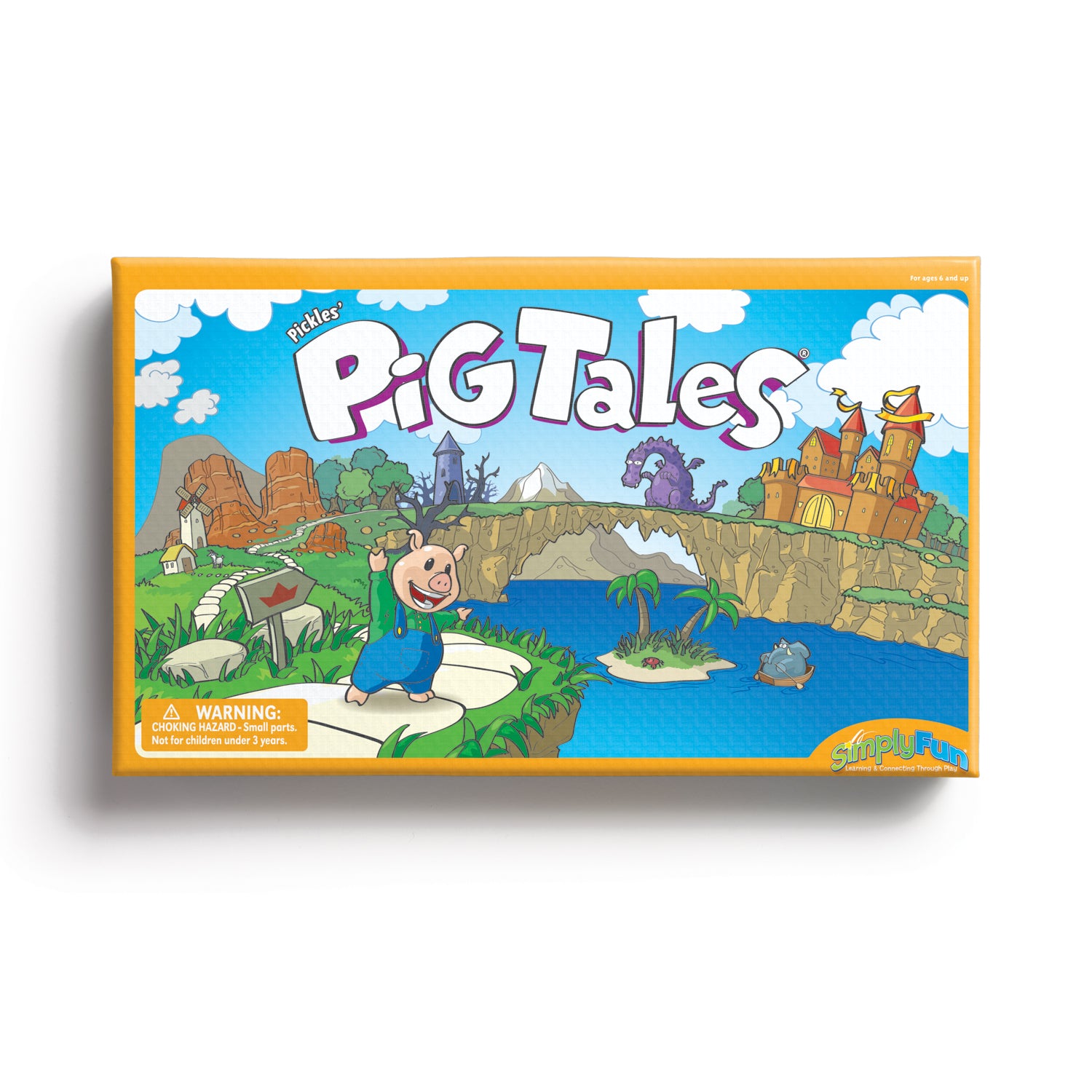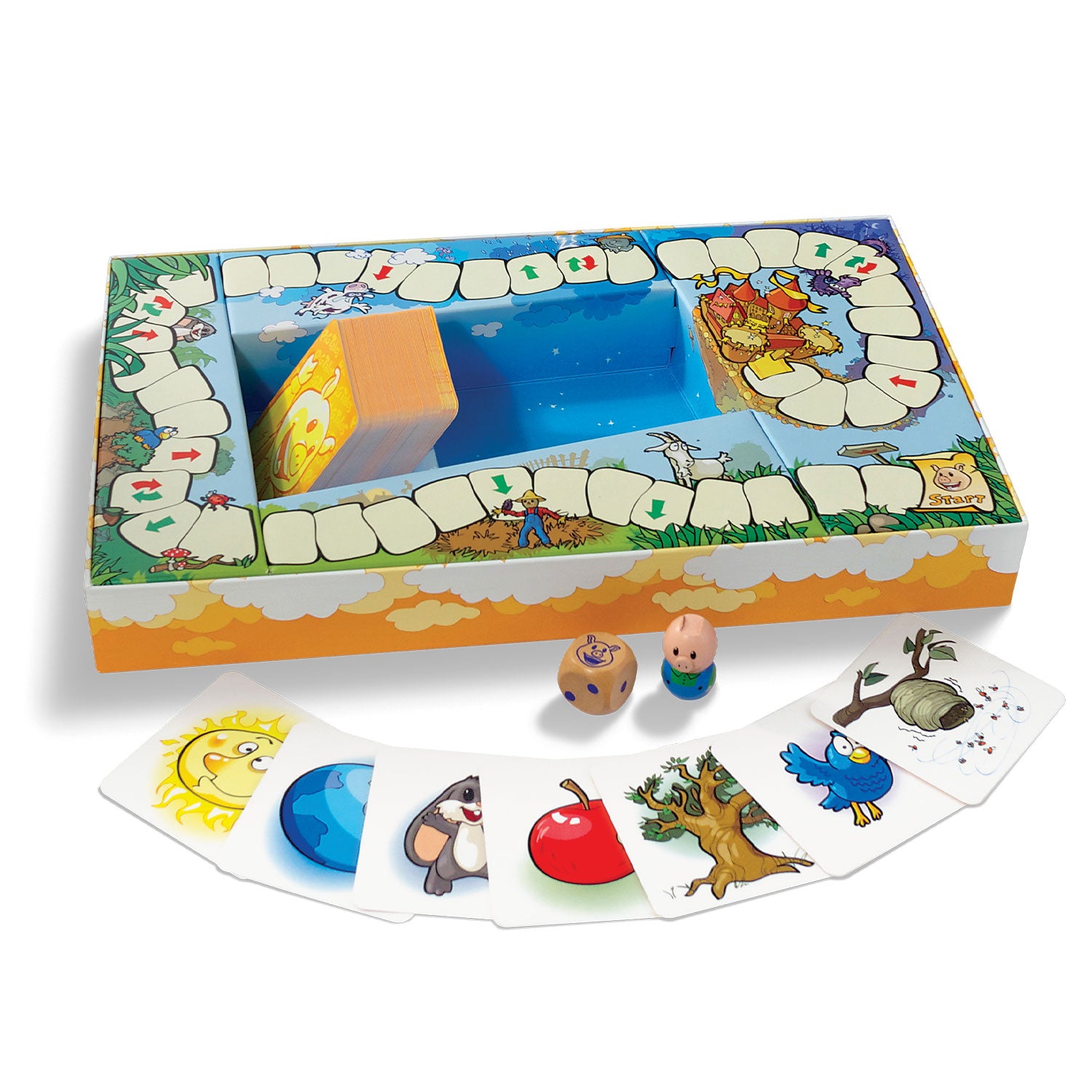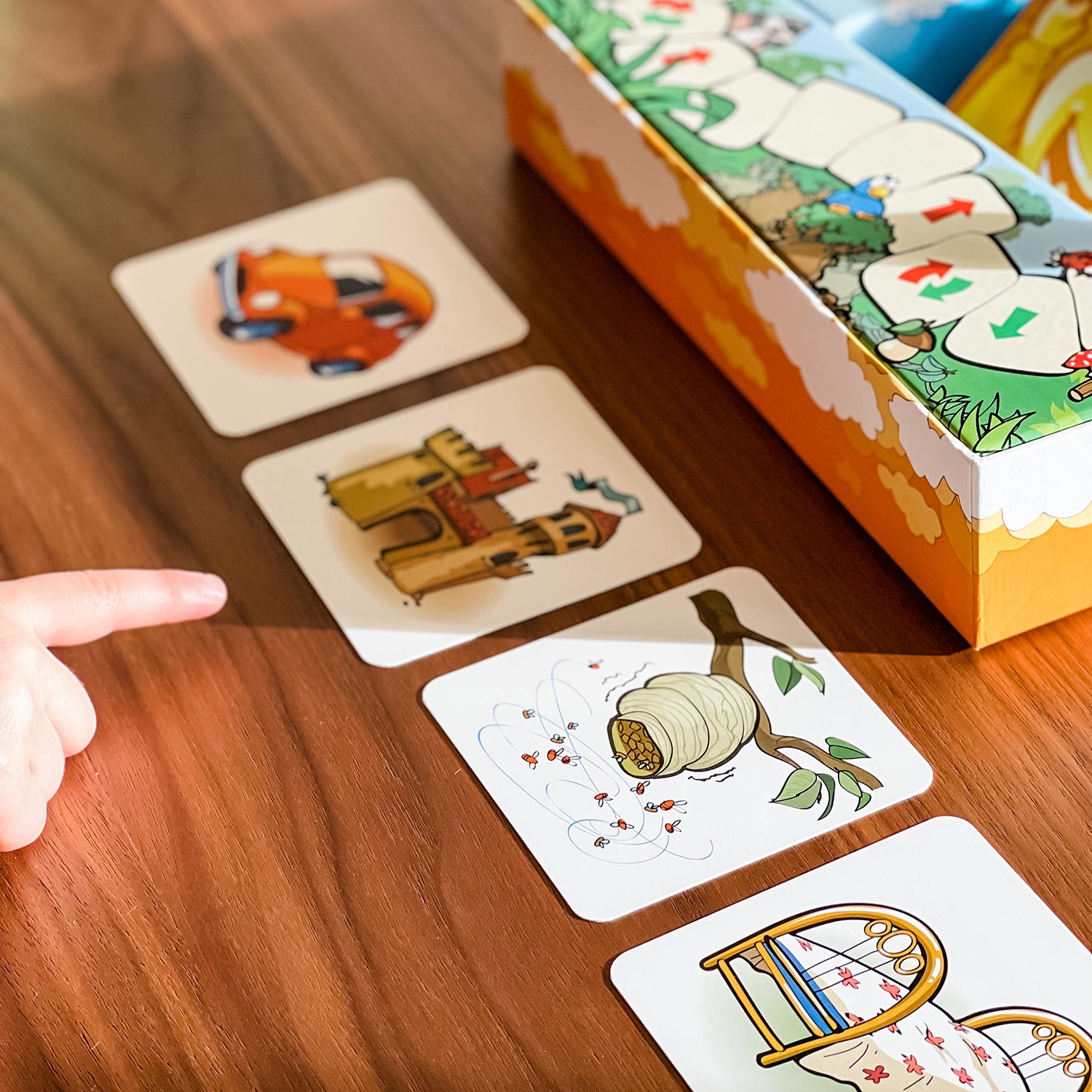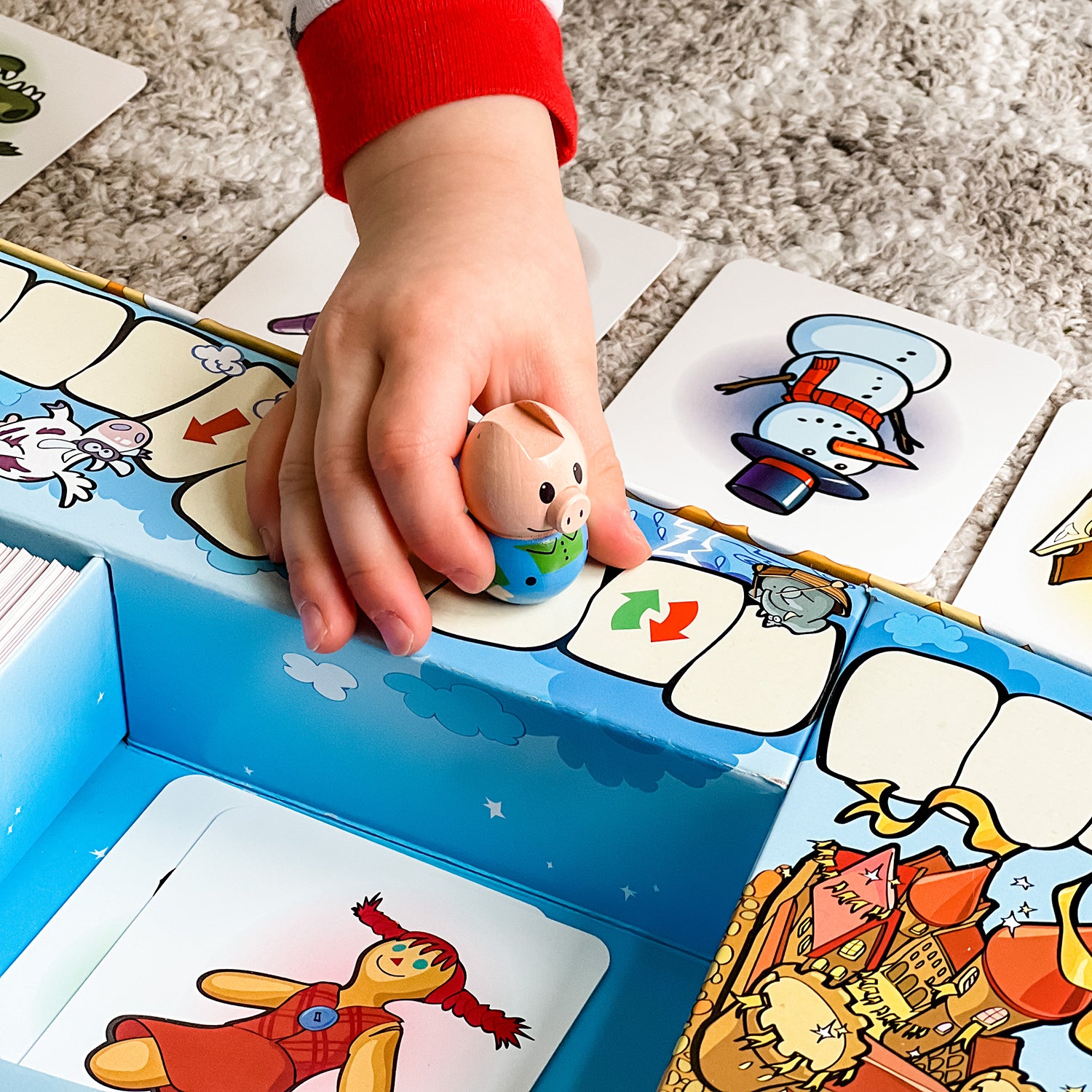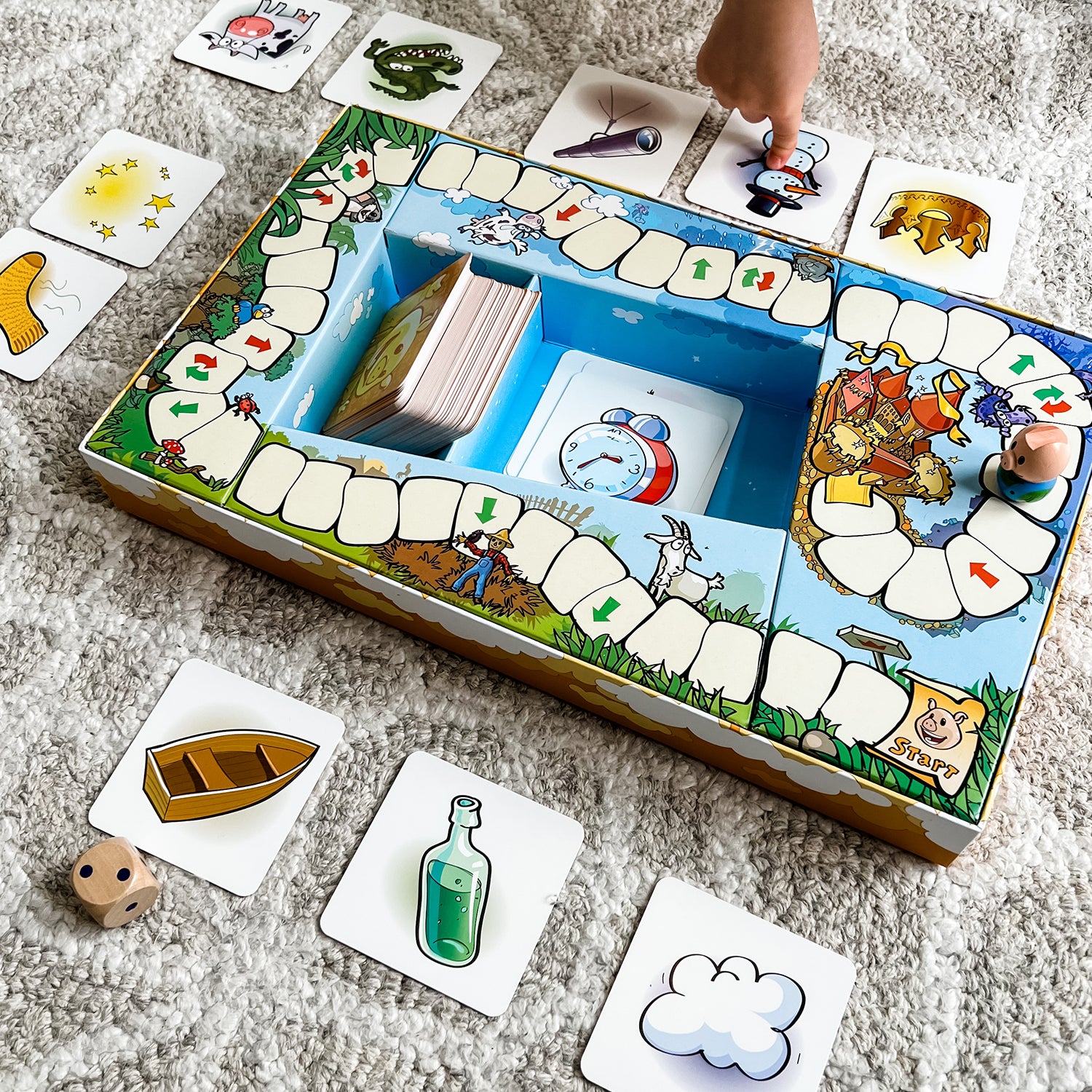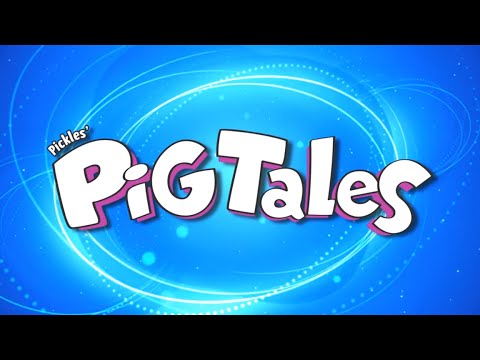Pickles' Pig Tales
Pickles' Pig Tales
2-5 players • 30 min • 6 & up
Focus: Story telling
Couldn't load pickup availability
Building storytelling skills has never been so fun. Tell the story from the beginning during each turn, then add one new sentence to it based on the object shown on the card drawn. Receive the card when you tell the story correctly from the beginning. The player with the most cards at the end of the game wins!
Skills: Story Telling, Communication
Game Includes
Game Includes
- 80 Story Cards
- 1 Pickles Pawn
- 1 Six-sided Die
- 1 Game Board
- 1 Rules Booklet
Share
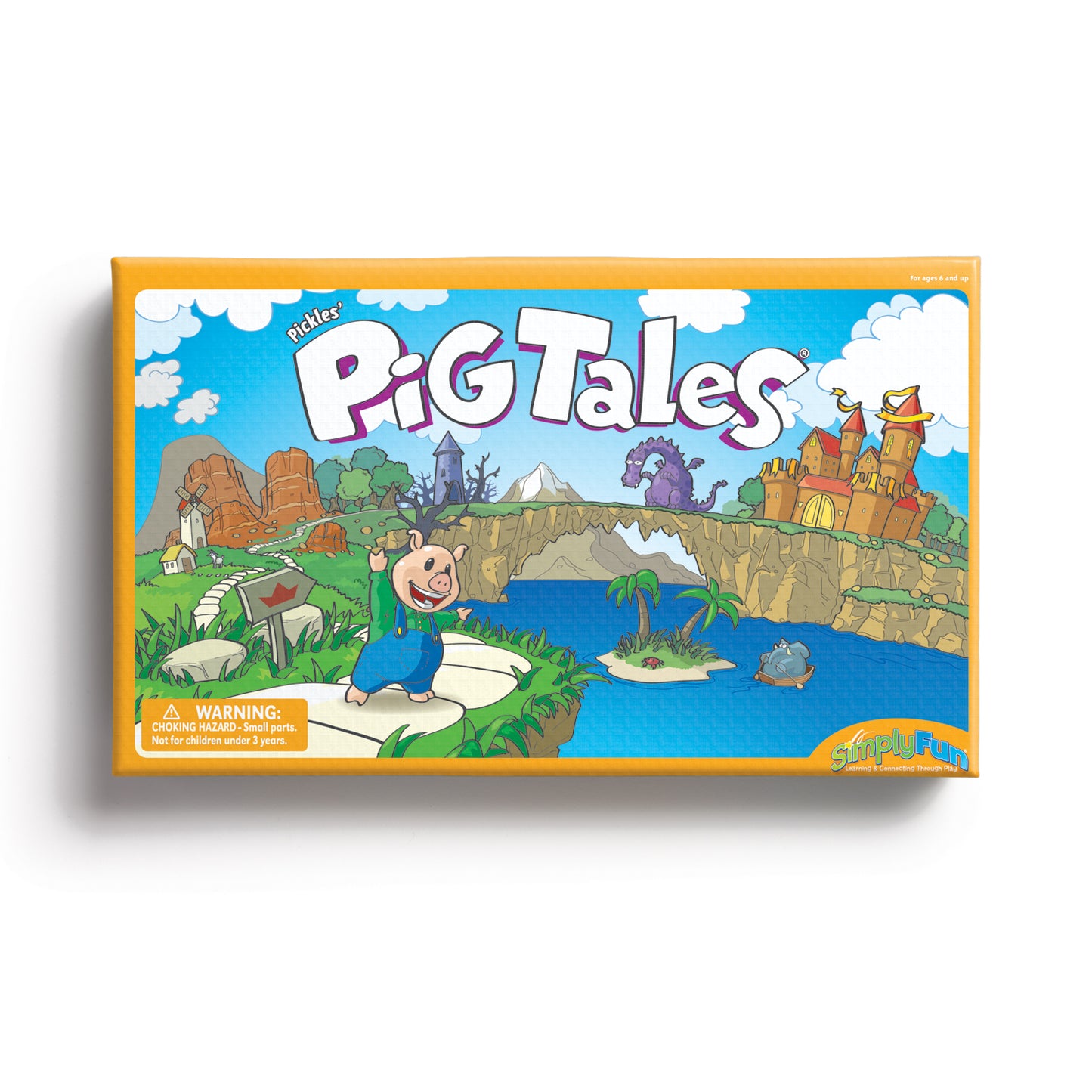
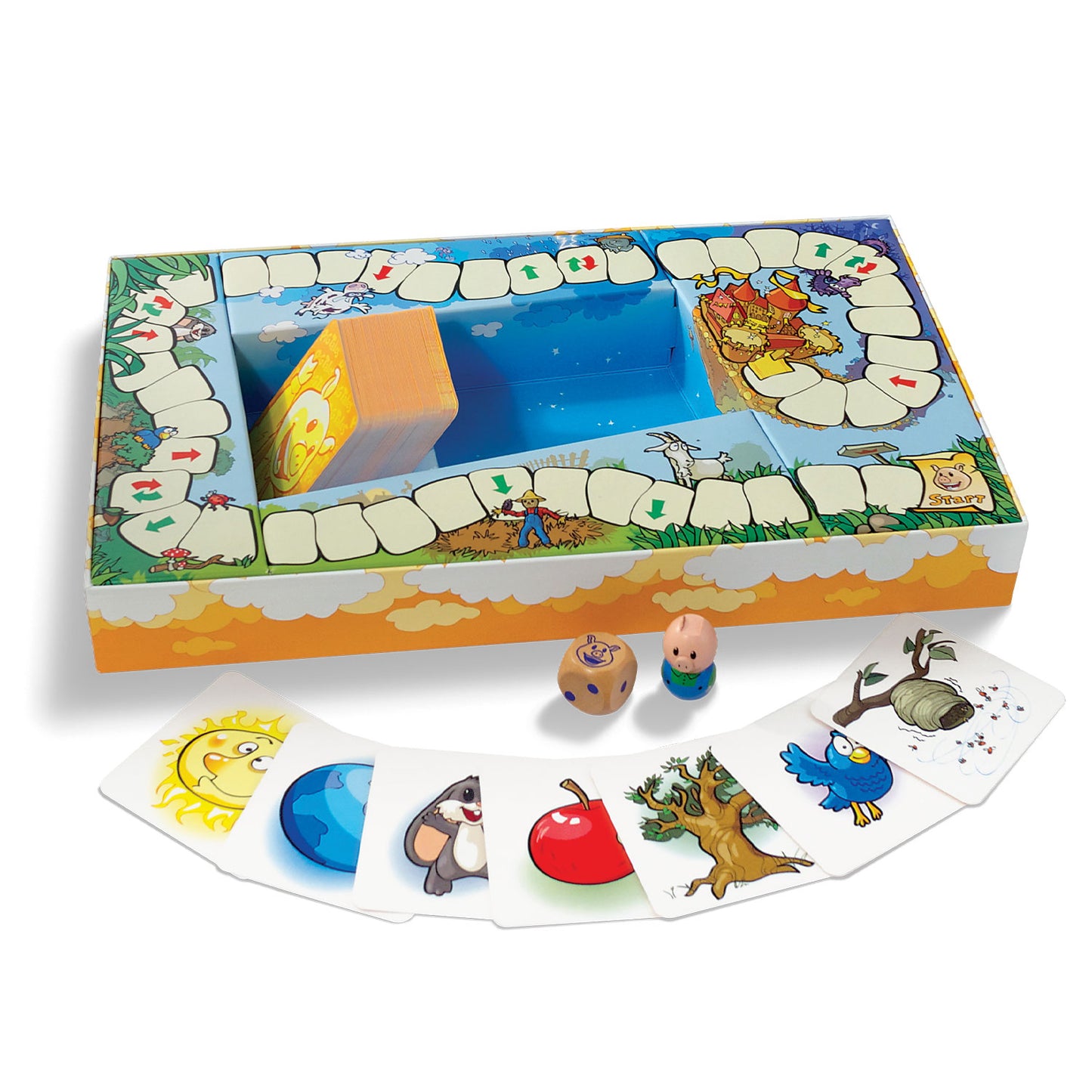
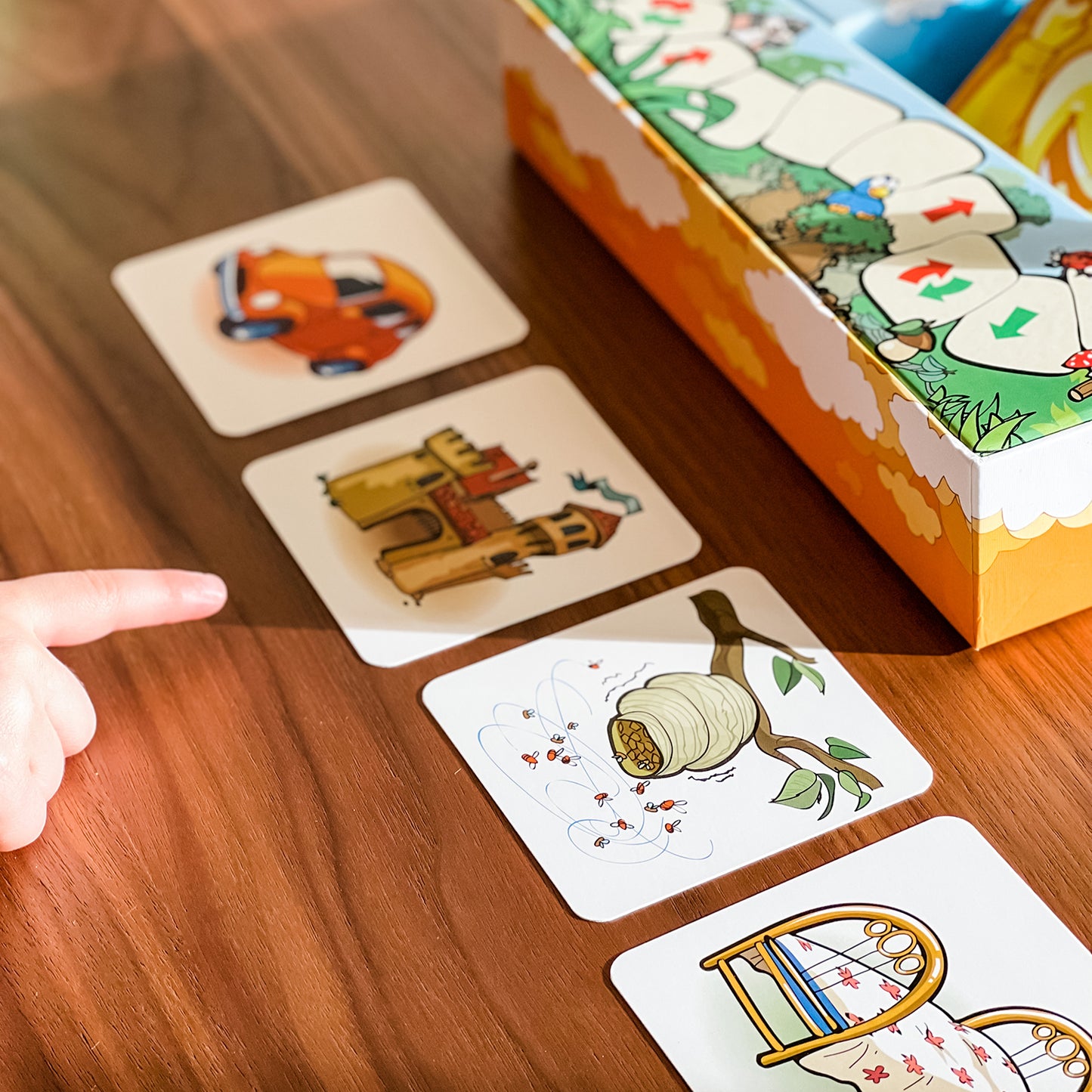
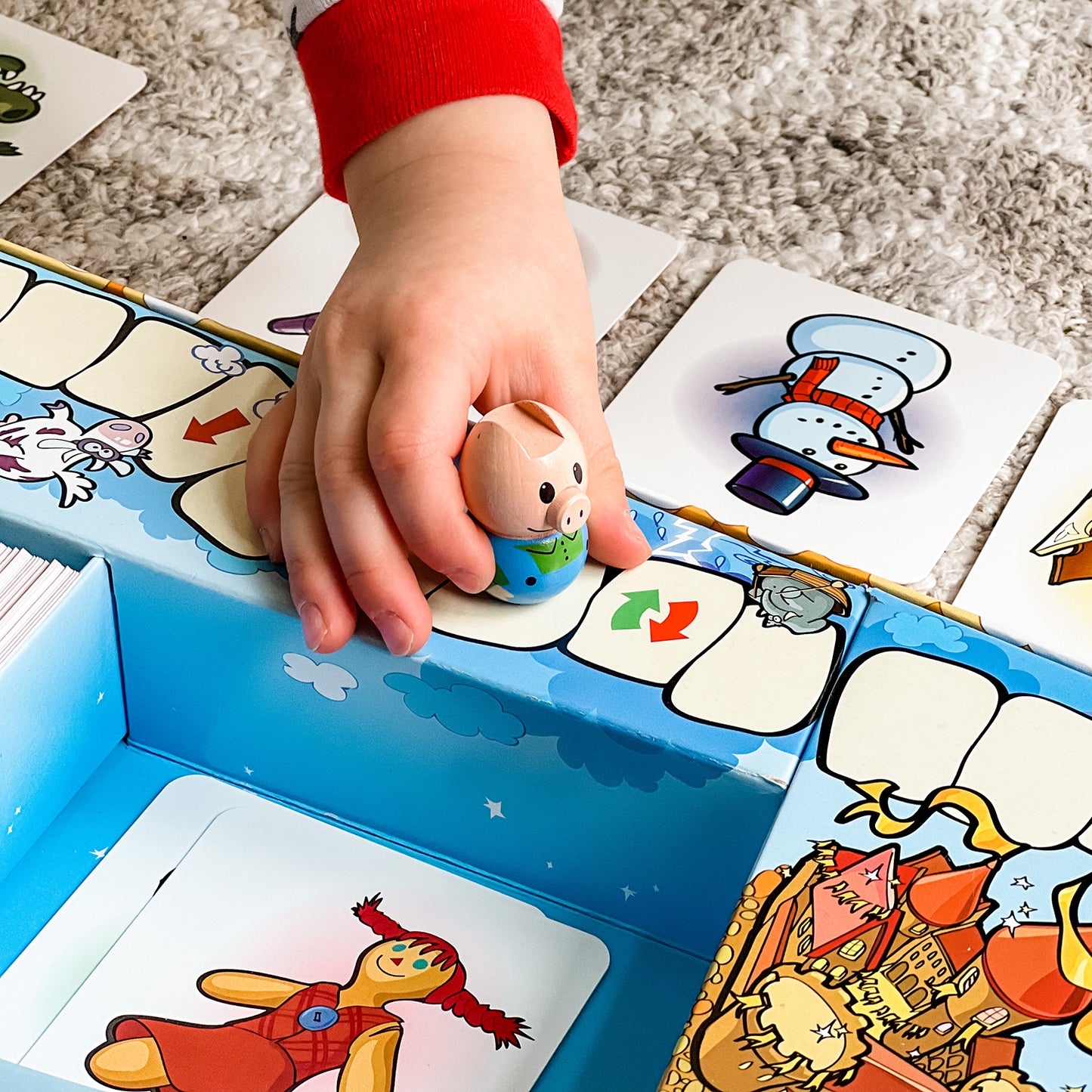
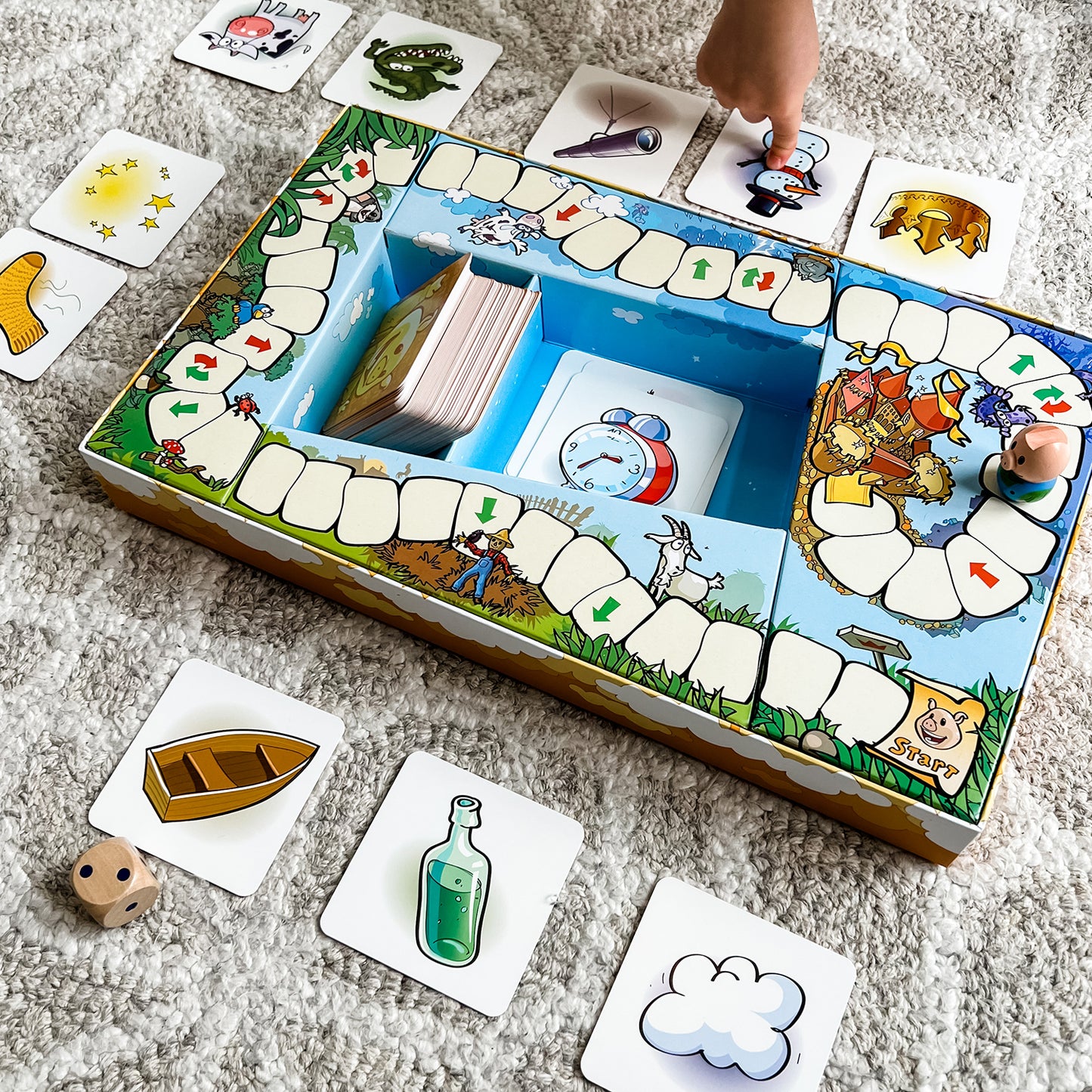
Collapsible content
How to Play
Educational Standards
Core Standard*: Language
Reading:
- Literature
- Key Ideas & Details Grade Level 1st
- Integration of Knowledge and Ideas Grade Levels 1st, 2nd
- Foundational Skills
- Phonological Awareness Grade Level 1st
Speaking and Listening
- Comprehension & Collaboration Grade Levels 1st, 2nd
- Presentation of Knowledge and Ideas Grade Levels 1st, 2nd
Language
- Conventions of Standard English Grade Levels 1st, 2nd
- Knowledge of Language Grade Level 2nd
- Vocabulary Acquisition and Use Grade Levels 1st, 2nd
Skills
Explore
What Does Child Do To Use Skill In The Game?
The goal of the game is to tell a story leading to the castle. This requires that players investigate the picture cards and think about what is in that picture that could be included in the story.
How Parents Can Assist Learning
Encourage children to look at the details in the Story Cards to think about associations with the object in the picture. As the pictures are primarily objects, the children may need prompting to think about "what happened" with the object. For example, the knight could be riding a horse, going to battle, needing to sleep or worried that he makes a lot of noise when he walks.When first playing the game, the adult may need to use gestures to point to cards and remind the child to include previous parts of the story.
Learning Implications and Educator Support
Encourage children to look at the details in the Story Cards to think about associations with the object in the picture. As the pictures are primarily objects, the children may need prompting to think about "what happened" with the object. For example, the knight could be riding a horse, going to battle, needing to sleep or worried that he makes a lot of noise when he walks.When first playing the game, the adult may need to use gestures to point to cards and remind the child to include previous parts of the story.
Determine
What Does Child Do To Use Skill In The Game?
Players need to determine how each of the pictures could be involved in a story. Also, players need to determine which Story Cards to add or remove if they land on special spots on the game board.
How Parents Can Assist Learning
If needed prompt children's thinking about a picture. Examples are: What does it do? What happened? What is inside?
Learning Implications and Educator Support
If needed prompt children's thinking about a picture. Examples are: What does it do? What happened? What is inside? Children are developing early strategy skills as they decide what cards to add or remove, and whom to take a card from, depending on the spaces they land on with Pickles.
Compare
What Does Child Do To Use Skill In The Game?
Players need to associate what is on Story Card on the table with the Story Card they select from draw pile, so they can connect the ideas represented on each Story Card into a story.
How Parents Can Assist Learning
If needed parents can help children determine how connections can be made. For example, if a snowman card and a football are drawn together, the parent might ask, "What could happen in the snow with a football?"
Learning Implications and Educator Support
If needed educators can help children determine how connections can be made. For example, if a snowman card and a football are drawn together, the educator might ask, "What could happen in the snow with a football?"
Also, educators can help children classify vocabulary by identifying how the child uses the Story Card, perhaps as a verb or a noun. To enhance vocabulary, encouarage children to describe the image on the Story Card before adding it to the story.
Remember
What Does Child Do To Use Skill In The Game?
This is the key element of the game. Players need to remember the sentences associated with each picture, remember the story sequence, and remember what was eliminated and added.
How Parents Can Assist Learning
If children need assistance, parents can point to the Story Card pictures in sequence. This may help children remember the order of the story. When you get a turn, you can model using gestures and voice intonation in storytelling. This is also a strategy to aide memory. Another technique for improving memory is to say ideas out loud. Allow young children to repeat the story each time, even if it is not their turn. This will help improve memory.
Learning Implications and Educator Support
If children need assistance, educators can point to the Story Card pictures in sequence. This may help children remember the order of the story. When you get a turn, you can model using gestures and voice intonation in storytelling. This is also a strategy to aide memory.
Plan
What Does Child Do To Use Skill In The Game?
This is some light planning in Pig Tales as players need to quickly decide what idea to add to the story, and what cards to add, remove or take from another player if they land on a special spot on the game board.
How Parents Can Assist Learning
No special parent support required. However, for younger children, allow them to take their time to think up a new idea to add to the story.
Learning Implications and Educator Support
Children are developing early strategy skills as they decide what cards to add or remove, and whom to take a card from, depending on the spaces they land on with Pickles. Suggest they think about potential benefits of a move.
Practice
What Does Child Do To Use Skill In The Game?
The child practices the essential memory skills of the game with every turn.
How Parents Can Assist Learning
Parents can celebrate each correct recitation, building the child's confidence and enjoyment. These can help with memory.
Learning Implications and Educator Support
Educators can celebrate each correct recitation, building the child's confidence and enjoyment. These can help with memory.Additionally, children are practicing story making, including proper use of vocabulary, grammar, syntax, character and plot.
Solve
What Does Child Do To Use Skill In The Game?
Each time players recite the sentence correctly, they are solving the linguistic problem of the game.
How Parents Can Assist Learning
Parents can celebrate each correct recitation, building the child's confidence and enjoyment.
Learning Implications and Educator Support
Educators can celebrate each correct recitation, building the child's confidence and enjoyment.Additionally, children are using skills like proper use of vocabulary, grammar, syntax, character and plot in order to continue to develop a coherent story, which can be wildly imaginative and creative.
Review
What Does Child Do To Use Skill In The Game?
Players need to review mistakes, so they correct their story on the next turn.
How Parents Can Assist Learning
Parents can give clues to help children remember or accurately recite the part of the story they missed.
Learning Implications and Educator Support
Educators can give clues to help children remember or accurately recite the part of the story they missed.
Demonstrate
What Does Child Do To Use Skill In The Game?
Players verbally shares the story, demonstrating their memory skills.
How Parents Can Assist Learning
There is no special parent support required.
Learning Implications and Educator Support
Educators can ask children to demonstrate their knowledge of vocabulary and literacy by discussing the different elements of the story that is created.
Imagine
What Does Child Do To Use Skill In The Game?
Players have to imagine possible actions associated with each picture and connect actions into a story.
How Parents Can Assist Learning
Parents can include imaginative elements to show children that it is okay to make up crazy things. For example, "The knight was actually a robot who could cook meals."
Learning Implications and Educator Support
Educators can include imaginative elements to show children that it is okay to make up crazy things. For example, "The knight was actually a robot who could cook meals."
Create
What Does Child Do To Use Skill In The Game?
Players cooperatively create a story by adding a new idea to the prior story.
How Parents Can Assist Learning
Parents can include imaginative elements to show children that it is okay to make up crazy things. For example, "The bee was king of the castle where the goldfish lived with the camel."
Learning Implications and Educator Support
Educators can include imaginative elements to show children that it is okay to make up crazy things. For example, "The bee was king of the castle where the goldfish lived with the camel."
*Data compiled from CCSSI ELA Standards, WA Science Standards, and Washington Social Studies Standards
Special Needs
Cognitive
Suggestions for How to Modify Play Experience
For children who have difficulty remembering the sequence of complex ideas, they can try to remember the sequence of animals names. Instead of switching cards, use the green arrows to move forward one; the red arrow to go back one space; and the double arrow to skip a turn. This will simplify the game.
If children can remember sentences, play as usual but without the omission and exchange of cards. This complexity may be distracting and frustrating for children with cognitive delays or memory concerns.
Simplify the game by drawing cards only on the board squares with arrows of any color. Do not omit or exchange cards.
Communication
Suggestions for How to Modify Play Experience
For children with language delays or disorders, telling a story may be too difficult. Modify the game to labeling the picture on the card and adding a descriptive or action word, for example, big elephant or elephant walk.
The adult can assist the child with language concerns by beginning the sentence and letting the child complete it. For example, "And after the snowman…the little boy took his kite and….then the a camel took…, etc. By beginning the sentence for each card, the adult prompts the memory for the next part. After several turns, point to a card and say just an initial prompt, leaving more for the child to remember and say.
Sensorimotor
Suggestions for How to Modify Play Experience
Picking up cards requires fine motor skill using a pincer grasp. Children who need practice with this task can be the "card turner" for other players.
Social Emotional/Behavioral
Suggestions for How to Modify Play Experience
Turn-taking is built into the game, but children with attention problems can be the "Turn Announcer." They watch the game and announce whose turn is next.
Children can be encouraged to count with other children as they move the Pickles.
Vision
Suggestions for How to Modify Play Experience
If they can't see the cards in front of the other players, other players or an adult can prompt them with a word cue if they can't remember the sequence.
Hearing
Suggestions for How to Modify Play Experience
Teach children playing the game the signs for the cards as they are drawn. There are simple signs for most of the cards, so children will have fun learning them. Have a book of signs available. This also increases the hearing impaired child's social interactions and communication.
*Data compiled from CCSSI ELA Standards, WA Science Standards, and Washington Social Studies Standards
Autism
Autism Strengths & Interests
Short Summary of Strengths & Interests
- Enjoys making up stories.
- Has a good memory for verbal details or phrases.
- Can add to stories created by others.
Is good at matching visual items
This game is not appropriate
Has a good memory for sensory details, including visual, touch, taste and smell
This game is not appropriate
Has a good memory for words, phrases and dialouge
Is This Game Appropriate? Yes
Description
Children who have an ability to remember words, phrases, and sentences will do well with the memory aspect of the game. The can use and enhance this strength as they accurately repeat the story as it develops with one card being added or removed each turn.
Has a good memory for pictures, numbers and patterns
Is This Game Appropriate? Yes
Description
Children who have good pictorial memory will be able to use the pictures as cues to the story sequence they need to recall. This game is not appropriate
Likes to put things in order or a sequence
Is This Game Appropriate? Yes
Description
A key aspect of the game is remembering a story in the correct sequence. This is a strength for many children with autism. The pictures representing each of the sections of the story serve as a cue to reinforce memory.
Learns through visualizing or "replaying" actions in their mind
Is This Game Appropriate? Yes
Description
If the children learn well by visualizing or replaying actions in their mind, they will enjoy using that ability in Pickles' Pig Tales. In particular, they need to rerun the mental tape of the story recited by the prior players in order to successfully recite the story on their turn. Children also may use this skill to give themselves ideas for adding their new creative part to the story. They may replay story aspects they remember from previously seen movies or books which they add to the Pig Tale story.
Likes activities with rules, such as math and phonics
This game is not appropriate
Is very concrete and literal
This game is not appropriate
Learns in small "chunks" (for example, phone numbers are 3 chunks of number xxx-xxx-xxxx that are combined together)
Is This Game Appropriate? Yes
Description
Some children learn by "chunks", e.g. they assemble information into a single concept and then combine that with other concepts to create and/or remember something more complex. In Pickles' Pig Tales, they can use this ability to make small chunks of a story which they connect together to recite the whole story.
Is good at nonverbal reasoning and logic
This game is not appropriate
Likes spatial problem solving
This game is not appropriate
Can read well with good vocabulary, though may not fully comprehend content
This game is not appropriate
Likes to use and has good fine motor skill
This game is not appropriate
Likes established routines or set ways of doing things
This game is not appropriate
Likes manipulating, constructing or building things
This game is not appropriate
Likes to use and has good musical abilities
This game is not appropriate
Likes to use and has good drawing skills
This game is not appropriate
Autism Special Considerations
Appears to ignore other's communication and/or has difficulty giving eye contact to a communication partner
Is This Game Appropriate for Child with Characteristic? Yes
Can Child with Characteristic Play Game w/o Modification? Yes
Strategies for Developing Compensatory Skills:
Look at the game instead of each other.
Use unusual or exaggerated inflection to begin a communication about the game. This attracts the child's attention.
Has difficulty understanding complex verbal directions
Is This Game Appropriate for Child with Characteristic? No
Can Child with Characteristic Play Game w/o Modification? No
Strategies for Developing Compensatory Skills:
The rules for this game are complex. Not recommended for children with special needs.
Uses vocabulary inaccurately or demonstrates echolalia (repeating another's speech)
Is This Game Appropriate for Child with Characteristic? No/span>
Can Child with Characteristic Play Game w/o Modification? No
Strategies for Developing Compensatory Skills:
The game is not appropriate for children with echolalia.
Gets stuck repeating a verbal topic or physical actions and/or has difficulty attending to others' actions or topic.
Is This Game Appropriate for Child with Characteristic? Yes
Can Child with Characteristic Play Game w/o Modification? Yes
Strategies for Developing Compensatory Skills:
Remind children about listening and watching others' before making their own comment or action.
Practice turn-taking. Use a cue, such as a touch on the shoulder, if needed.
Reinforce attention and actions by commenting on what was done correctly. For example, "That was a good idea!"
Has difficulty producing speech/communication
Is This Game Appropriate for Child with Characteristic? No
Can Child with Characteristic Play Game w/o Modification? No
Strategies for Developing Compensatory Skills:
Unless all players understand and use sign language, this game is not recommended for children with language concerns. The game requires production of connected sentences in a specific sequence.
Has difficulty sequencing multi-step actions and/or doing complex abstract tasks
Is This Game Appropriate for Child with Characteristic? No
Can Child with Characteristic Play Game w/o Modification? No
Strategies for Developing Compensatory Skills:
Pig Tales requires an accurate memory, reproduction and sequencing of others sentences. In addition, rules for what to change or leave out would be confusing for children with special needs. Not recommended for children with this concern.
Demonstrates difficulty initiating and maintaining social interactions
Is This Game Appropriate for Child with Characteristic? No
Can Child with Characteristic Play Game w/o Modification? No
Strategies for Developing Compensatory Skills:
Pig Tales is a highly social game requiring players to pay attention to each others' turns and remember what was said. It would be too challenging for many children with special needs.
Acts out or demonstrates avoidance behaviors when frustrated, overwhelmed, or needs more sensory input.
Is This Game Appropriate for Child with Characteristic? Yes
Can Child with Characteristic Play Game w/o Modification? No
Strategies for Developing Compensatory Skills:
Reduce extraneous noise or allow the child to wear head phones or ear plugs if loud sounds cause anxiety.
A weighted vest worn during the game may provide additional pressure input and thus reduce fidgeting due to sensory needs. Pressure can be calming when used for no more than 20 minutes at a time.
Practice a phrase to ask for help and role play situations in the game where it is needed.
Provide techniques for self-calming, such as holding a special toy.
Has short attention span for non-preferred activities
Is This Game Appropriate for Child with Characteristic? No
Can Child with Characteristic Play Game w/o Modification? No
Strategies for Developing Compensatory Skills:
Not recommended for children with a short attention span. The game requires concentration.
Needs sameness or consistent routines and/or has difficulty with transitions from one activity to another
Is This Game Appropriate for Child with Characteristic? Yes
Can Child with Characteristic Play Game w/o Modification? Yes
Strategies for Developing Compensatory Skills:
Play games at the same time every day, so the child anticipates the game routine.
Change the location of the game, so the child may play in different rooms, at the table, or on the floor. This will build tolerance for variation.
Prepare the child ahead time for the introduction of a new game. Talk about aspects that will be motivating for the child, and let them explore the parts of the game before setting out the whole game.
Provide a structure for placement of game pieces that can be the same each time the game is played. For example, have a specific location for where the board goes, the pieces, etc.
Involve the child verbally and with actions for the transition to the game table or at the end of game play. For example, you might say, "Let's look at the pictures on the game box and guess what it is about."
Use an object cue. Let the child hold an object from the game or activity you want to introduce prior to the transition. For example, if you were intending to play Pig Tales, you would hand the child Pig Tale card and say, "What game does this card go in."
Has difficulty understanding others' feelings, intentions, and the reasons for others' actions.
Is This Game Appropriate for Child with Characteristic? Yes
Can Child with Characteristic Play Game w/o Modification? Yes
Strategies for Developing Compensatory Skills:
Pig Tales requires paying attention to others. A child with an excellent verbal memory could play even if they didn't understand the reasons or feelings inherent in the content of the statements.
*Data compiled from CCSSI ELA Standards, WA Science Standards, and Washington Social Studies Standards
Extended Play
Extra Ways to Play the Game
Each player picks 10 cards. From these 10, the player picks 5 cards. Each player tells a story with his/her 5 cards. All players look at the cards they discarded and see if they can add a card to the player's story. Everyone comments on what they like about each story.
Materials Needed
No additional materials needed.
Developmental Benefits
This modification encourages children to plan and organize, relating ideas to make a story and building language and cognitive skills. The ability to add from their own pile to make the story more complex requires the ability to restructure the original story. Having children comment positively on each other's stories builds supportive social skills.
Extra Ways to Play the Game
Lay 20 cards out in a row on the floor or table. Together create a story. You can move the cards around to make the story better. Keep changing it, until everyone likes the story. Invite Mom or Dad in to hear the story.
Materials Needed
No additional materials needed.
Developmental Benefits
Creating a story out of divergent cards encourages children to make creative connections. Cooperation is necessary, so social skills are also needed. Adding the element of performance builds self esteem and self confidence.
Extra Ways to Play the Game
Draw a card and act out what is on the card. Others guess what is on the card. Draw two or more cards and act out a story that it tells. Others guess the story you are telling.
Materials Needed
No additional materials needed.
Developmental Benefits
Children need to grasp the core meaning of what is on a card and think of something they can do to represent the object or action. This requires imagination and elaboration with gross and fine motor skills. Eliminating verbal communication builds the child's nonverbal expressive skills.
Extra Ways to Play the Game
Each player picks 2 cards and lays them in the middle so all can see the. Player 1 then thinks of a way the pictures are alike (e.g, the sun and the elephant are both big). Other players vote on whether they like the comparison. If most players give the player a "thumbs up," they scores a point. If anyone can come up with another comparison, a vote is taken again, and that player can score a point. The next player then proceeds to lay down two cards, etc.
Materials Needed
No additional materials needed.
Developmental Benefits
This modification encourages children to make analogies, an important cognitive skill. The process of listening to others ideas often leads to children making a new association. Voting thumbs up and down encourages children to evaluate another's idea to determine a logical connection. If their is disagreement, children should be encouraged to explain and justify their thinking. Being able to support one's ideas and convince others of the value of an approach builds self confidence.
Extra Ways to Play the Game
See if you can find a card for each letter of the alphabet and line them up.
Materials Needed
No additional materials needed.
Developmental Benefits
This modification encourages sound-letter association and letter sequencing. Both are important foundations for literacy.
*Data compiled from CCSSI ELA Standards, WA Science Standards, and Washington Social Studies Standards
Collapsible content
How to Play Video & Transcript
This is one of those games where you help build a story together. Up to five players aged 6 and older can play.
The game comes with a stack of 80 cards with a variety of fun objects, and a game board built right into the box. It also comes with this cute little character: Pickles: the star of the show!
This game introduces children to descriptive terms to expand their vocabulary. The sequencing aspect of the game helps children practice sentence structure as well as building memory.
To play Pig Tales, shuffle the deck of cards and place them in the small pocket in the game board. The hungriest player starts the game.
On your turn, roll the die and move Pickles ahead on the game track. If the die shows Pickles' smiling face, do nothing this turn, and the next player plays immediately. However, in most cases, you will draw a story card and begin telling a story based on the picture the card shows.
As more cards are added, this story grows longer. Each player must tell the story correctly, describing the cards in the order they were drawn. If the story is told correctly, the player keeps the face-up card in front of themselves, and the following players must include the card when telling the story.
A few spaces on the track have arrows. A green arrow means the player adds a new card, but does not recite the story. It will be up to the next player to decide how this new element is included.
A red arrow means the player removes one of their cards, but does not recite the story. It will be up to the next player to remove this element from the story on their turn.
When Pickles reaches the castle space on the game board, the game ends. The player who collected the most cards wins!
One of the great things about this game is it does not require any written language skill. An easy ways to introduce this game is to deal out a couple cards in a row telling the story as you go, and then turn over a third card and ask your child what happens next?
Pickles' Pig Tales is a lot of fun for all ages. Try it at a social gathering of adults and see who can keep up with the twists your story takes as cards are added and removed from the plot. There's hilarious creativity in justifying why the bar of soap from the early version of your tale has turned into a surprised crocodile!
- Choosing a selection results in a full page refresh.
- Opens in a new window.

